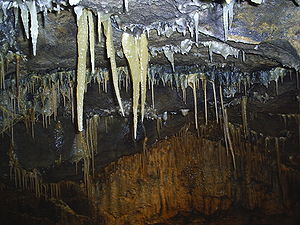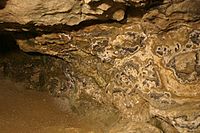Difference between revisions of "Blue John Cavern"
(Created page with "{{Infobox cave |name=Blue John Cavern |county=Derbyshire |picture=Blue John cavern.jpg |picture caption=Entrance to the Blue John cavern |depth= |length= |latitude=53.3456 |...") |
|||
| Line 2: | Line 2: | ||
|name=Blue John Cavern | |name=Blue John Cavern | ||
|county=Derbyshire | |county=Derbyshire | ||
| − | |picture= | + | |picture=Stalactites at blue john images 2006.JPG |
| − | |picture caption= | + | |picture caption=Stalactites in the Blue John Cavern |
|depth= | |depth= | ||
|length= | |length= | ||
| Line 15: | Line 15: | ||
The miners who work the remaining seams are also the guides for underground public tours. The eight working seams are known as Twelve Vein, Old Dining Room, Bull Beef, New Dining Room, Five Vein, Organ Room, New Cavern and Landscape. | The miners who work the remaining seams are also the guides for underground public tours. The eight working seams are known as Twelve Vein, Old Dining Room, Bull Beef, New Dining Room, Five Vein, Organ Room, New Cavern and Landscape. | ||
| − | |||
In 1865, Blue John Cavern was the site of the first use of magnesium to light a photograph underground. It was taken by Manchester photographer Alfred Brothers.<ref>{{cite news|url=http://books.google.com/books?id=yINSqbNUNM0C&pg=PA14&lpg=PA14|title=Art of Darkness|author=Chris Howes|publisher=New Scientist|date=1989-12-23|accessdate=2014-07-05}}</ref> | In 1865, Blue John Cavern was the site of the first use of magnesium to light a photograph underground. It was taken by Manchester photographer Alfred Brothers.<ref>{{cite news|url=http://books.google.com/books?id=yINSqbNUNM0C&pg=PA14&lpg=PA14|title=Art of Darkness|author=Chris Howes|publisher=New Scientist|date=1989-12-23|accessdate=2014-07-05}}</ref> | ||
==Blue John== | ==Blue John== | ||
| − | [[File:Blue John Veins in the Blue John Cavern.jpg|thumb| | + | [[File:Blue John Veins in the Blue John Cavern.jpg|left|thumb|200px|Blue John seams in the cavern]] |
In the UK Blue John, or "Derbyshire Spar", is found only in Blue John Cavern and the nearby [[Treak Cliff Cavern]]. It is a type of banded fluorite. The most common explanation for the name is that it derives from the French ''bleu-jaune'', meaning 'blue-yellow', but other derivations have been suggested.<ref>{{cite book | title=An Gerlyver Meur: Cornish-English, English-Cornish Dictionary | first=Ken | last=George | year=2009 | publisher=Cornish Language Board | isbn=1-902917-84-7}}</ref> | In the UK Blue John, or "Derbyshire Spar", is found only in Blue John Cavern and the nearby [[Treak Cliff Cavern]]. It is a type of banded fluorite. The most common explanation for the name is that it derives from the French ''bleu-jaune'', meaning 'blue-yellow', but other derivations have been suggested.<ref>{{cite book | title=An Gerlyver Meur: Cornish-English, English-Cornish Dictionary | first=Ken | last=George | year=2009 | publisher=Cornish Language Board | isbn=1-902917-84-7}}</ref> | ||
| Line 31: | Line 30: | ||
Blue John Cavern is also visited by a couple in the 2013 film ''Sightseers''. | Blue John Cavern is also visited by a couple in the 2013 film ''Sightseers''. | ||
| − | == | + | ==Outside links== |
| − | * [http://www.bluejohn-cavern.co.uk/ Blue John Cavern] | + | [[File:Blue John Cavern entrance.jpg|right|thumb|200px|Entrance to the Blue John Cavern]] |
| + | {{commons}} | ||
| + | *[http://www.bluejohn-cavern.co.uk/ Blue John Cavern] | ||
==References== | ==References== | ||
Latest revision as of 17:41, 26 February 2015
| Blue John Cavern | |
| Derbyshire | |
|---|---|
 Stalactites in the Blue John Cavern | |
| Co-ordinates: | 53°20’44"N, 1°48’13"W |
The Blue John Cavern in Derbyshire is one of the four show caves in ther Peak District near Castleton, Derbyshire. The cavern takes its name from the semi-precious mineral, Blue John, which is mined here; a mineral found nowhere else in the world apart from the neighbouring Treak Cliff Cavern. Blue John is still mined in small amounts outside the tourist season and made locally into jewellery. The deposit itself is about 250 million years old.
The miners who work the remaining seams are also the guides for underground public tours. The eight working seams are known as Twelve Vein, Old Dining Room, Bull Beef, New Dining Room, Five Vein, Organ Room, New Cavern and Landscape. In 1865, Blue John Cavern was the site of the first use of magnesium to light a photograph underground. It was taken by Manchester photographer Alfred Brothers.[1]
Blue John
In the UK Blue John, or "Derbyshire Spar", is found only in Blue John Cavern and the nearby Treak Cliff Cavern. It is a type of banded fluorite. The most common explanation for the name is that it derives from the French bleu-jaune, meaning 'blue-yellow', but other derivations have been suggested.[2]
Elswewhere in the world similar blue-banded fluorite is found, but the locations are rare.
In popular media
The cavern was featured on the 2005 TV programme Seven Natural Wonders as one of the wonders of the Midlands.
In the 2010 series of How it's Made, the cave and jewellery production of Blue John was featured.
Blue John Cavern is also visited by a couple in the 2013 film Sightseers.
Outside links
| ("Wikimedia Commons" has material about Blue John Cavern) |
References
- ↑ Chris Howes (1989-12-23). "Art of Darkness". New Scientist. http://books.google.com/books?id=yINSqbNUNM0C&pg=PA14&lpg=PA14. Retrieved 2014-07-05.
- ↑ George, Ken (2009). An Gerlyver Meur: Cornish-English, English-Cornish Dictionary. Cornish Language Board. ISBN 1-902917-84-7.

